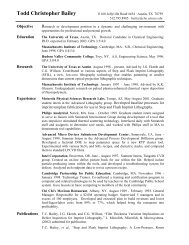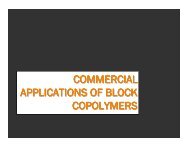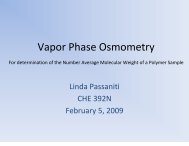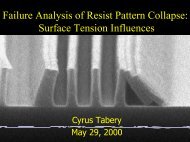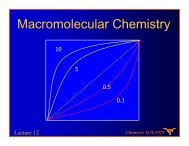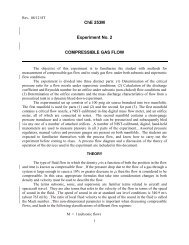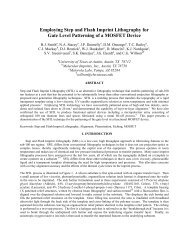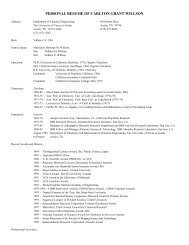Asymmetric fluid-structure dynamics in nanoscale imprint lithography
Asymmetric fluid-structure dynamics in nanoscale imprint lithography
Asymmetric fluid-structure dynamics in nanoscale imprint lithography
- No tags were found...
Create successful ePaper yourself
Turn your PDF publications into a flip-book with our unique Google optimized e-Paper software.
developed <strong>in</strong> efforts to reduce current l<strong>in</strong>e widths. X-ray and EUV offer an orderof magnitude potential improvement <strong>in</strong> l<strong>in</strong>e widths.While some of the processes currently <strong>in</strong> development have demonstratedthe ability to resolve sub-100 nm features <strong>in</strong> the laboratory, there are technicaland cost considerations that must be overcome to realize their potential benefits.These processes require optical exposure systems that are rare and expensive.Also, x-ray <strong>lithography</strong> requires a helium atmosphere and x-ray masks havestability problems. Furthermore, these processes have throughput problems. Theeffects of wave diffraction, <strong>in</strong>terference, resist sensitivity, and stand<strong>in</strong>g waveeffects limit these optical <strong>lithography</strong> techniques [Chou, Krauss, and Renstrom1996]. Furthermore, there is the problem of resist transparency as materials thatare transparent to DUV light are opaque to EUV and x-ray regions. With many ofthese issues unresolved, it is near certa<strong>in</strong>ty that optical methods will not beadequate for <strong>nanoscale</strong> (below 100 nm) <strong>lithography</strong> [Whidden et al. 1996].High-energy particle <strong>lithography</strong> schemes such as electron beam (E-beamdirect write/project) and ion beam <strong>lithography</strong> that have been used to producehigh-resolution patterns, and is used to write and repair photomasks. However,for wafer process<strong>in</strong>g, they have problems with cost and throughput. Thesesystems operate serially and cannot ma<strong>in</strong>ta<strong>in</strong> the level of throughput required foreconomic manufacture of circuits. Furthermore, there exist proximity effects dueto elastic and <strong>in</strong>elastic particle collisions. These are referred to as forwardscatter<strong>in</strong>g <strong>in</strong> the photoresist and backscatter<strong>in</strong>g from the substrate. Thesefundamental technical challenges and high cost clearly necessitate the search forlow cost, high-throughput alternatives to optical <strong>lithography</strong>. SFIL is one suchprocess that has demonstrated the generation of sub 100 nm features.7



